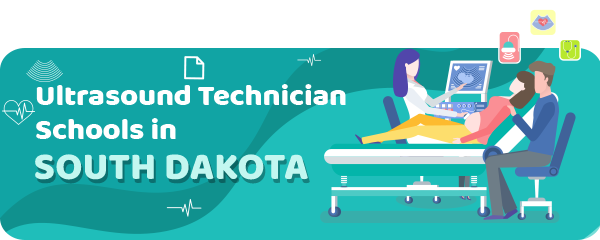South Dakota is the country’s 5th least populated state and most job opportunities are to be found in Sioux Falls.
It’s expected that the demand for ultrasound technicians to grow 20% by 2024, meaning this is a great time to consider becoming one.
The main task of an ultrasound technician is to use a specially designed machine to take pictures of the inner structures of a body.
Article Table of Contents
Getting Certified
While it’s not mandatory to have a certification, it is a good idea to get one, to increase the chances of finding employment.
The institution issuing certifications for ultrasound technicians is ARDMS or the American Registry for Diagnostic Medical Sonography.
Their certificate is only given to those who pass their exam, and there are certain conditions to be met to be accepted in the examination.
The most popular is completing an accredited training program, though other ways do exist and are accepted.
This exam and certification are recognized nation-wide.
The training programs need to include hands-on practice in a setting identical to the one the professional will carry out their duties.
Future technicians will also develop the following skills:
- Effective communication
- Record keeping
- Operating the ultrasound devices
- Physiology and medical ethics
| School Name | Address |
|---|---|
| Mount Marty College | 1105 W 8th St, Yankton, SD 57078 |
| Presentation College | 1500 N Main St, Aberdeen, SD 57401 |
| Southeast Technical Institute | 2320 N Career Ave, Sioux Falls, South Dakota 57107 |
| University of Sioux Falls | 1101 W 22nd St, Sioux Falls, SD 57105 |
Some schools don’t have ultrasound technician training programs, but they might have radiology training programs.
These programs are a good substitute for the ultrasound and sonography programs.
Radiology can also be a good introduction to this medical field.
Specializations
The ultrasound field has several specializations.
Each area uses different machines and methods to investigate the human body.
These fields are:
- Sonography
- MRI
- Radiology
- EKG
- Vascular sonography
- Ultrasound
For each of these areas has specific topics that would be taught during the educational programs.
The subjects might include:
- anatomy,
- records management
- physiology,
- medical psychology,
- medical ethics
- imaging technology.
Salary Expectations
Within each field, there are further specializations possible.
Depending on the chosen specialization and experience, the salary will vary greatly.
Annual Salary Range:| Location | Avg. Annual Salary |
|---|---|
| Sioux Falls | $67,050 |
| Rapid City | $66,399 |
| Aberdeen | $62,352 |
| Brookings | $65,902 |
| Watertown | $65,902 |
| Mitchell | $65,902 |
| Yankton | $64,433 |
| Pierre | $63,500 |
| Huron | $64,127 |
| Spearfish | $65,252 |
Regional Salary in South Dakota
| Region | Employed | Avg. Annual Salary | Avg. Hourly Pay | Top 10% Annual Salary | Bottom 10% Annual Salary |
|---|---|---|---|---|---|
| Rapid City, SD | 60 | $73,260 | $35.22 | $84,720 | $59,700 |
| Sioux Falls, SD | 210 | $67,190 | $32.3 | $82,810 | $42,080 |
* Employment conditions in your area may vary.
Further Information
By attending a training program, individuals have the possibility of earning a degree, such as the Associates’ or the Bachelors’.
Depending on the desired degree, the program will vary in length as well.
The Associates’s degree is earned after 2 years of study and the Bachelors’s after 4 years of study.
A simple diploma or certificate can be earned after 1 year of education.
The type of credential earned will also influence the salary and the chances of developing a career in the field.
Those interested in enrolling in one of these programs might have a deeper knowledge of subjects like anatomy or math.
Read the full guide: How to Become an Ultrasound Technician
